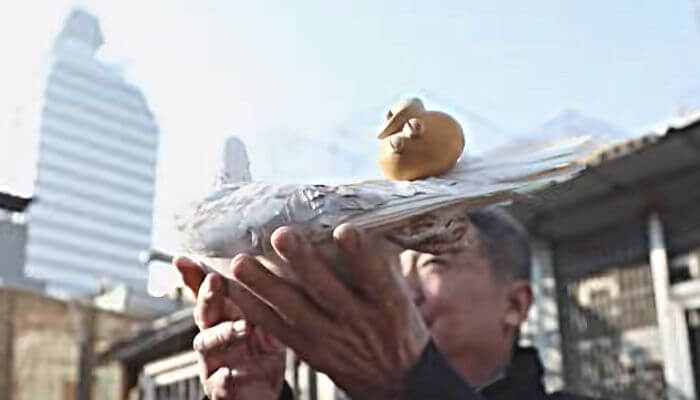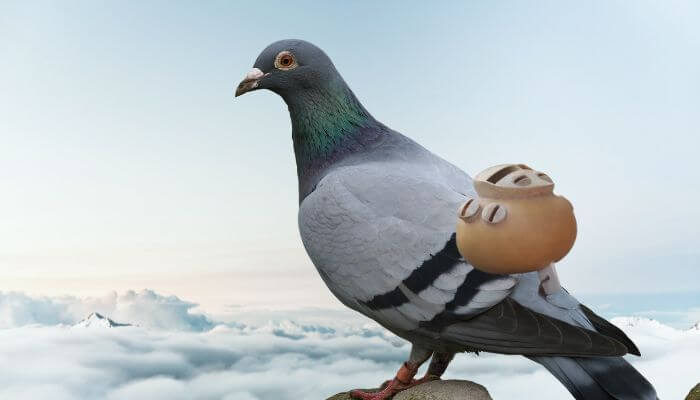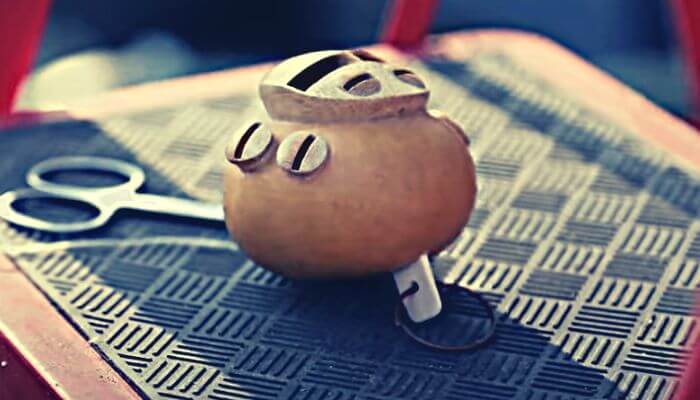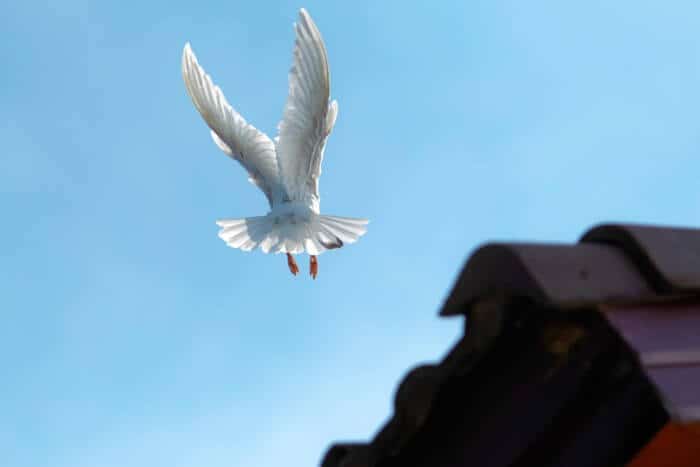Pigeon whistles are a small device that is attached to a pigeon that emits a whistling noise while the bird is in flight.
Originating from China, it is used for musical entertainment, to track birds and also as a deterrent for birds of prey.

What Is a Pigeon Whistle?
A pigeon whistle also sometimes known as a pigeon flute, geling 鸽铃 or geshao 鸽哨 in China, is a small, lightweight whistling instrument that is attached to the tail feathers of a pigeon and then carried by the bird in order to create a wonderfully haunting sound when it is in flight.
Traditional whistles were made from lightweight materials like bamboo and hollowed-out gourds and were attached using toggles to ensure no harm was caused to the bird.
The original uses of pigeon whistles ranged from attaching them to birds in order to deter predators who might be in the mood for an easy pigeon-shaped snack, to incorporating pigeons into human warfare and battle strategy by using them to create a tactical diversion against an enemy army.
Its beauty however is not in warfare or deterrence but in the enjoyment of the interesting and unique sounds that are created by the carrier bird in flight.
How Do Pigeon Whistles Work?
The device is fixed to the rear of the bird.
This places the whistle in direct line of the jet stream of air that is produced when pigeons are in full flight.
Then the passage of air through the device makes a sound – in the same way as blowing a musical instrument like a flute.
When flying at appropriate speeds, the air is pushed through a larger hole at the front of the whistle and forced into a smaller hole at the back.
The result is a high-pitched sound that continues for as long as the air is being pushed through.
The tiny tunnels and holes (apertures) in the pigeon whistles can vary in width and this can shape the airflow differently as it leaves the chamber.
What results from these varying apertures is a different note as the pigeons fly around.
Effectively, this means that depending on how many pigeons you send off flying with whistles attached to their rear feathers, you can achieve a full symphony of sounds.

Sound can vary with different flight trajectories as well as speed.
With the natural acrobatics of a pigeon in flight, wind can actually pass over the whistle entirely, resulting in a completely mute sound.
It can be a bit of a learning curve to learn about the individual style and acrobatics of your pigeons, so you’ll need a few experiments and unsuccessful tries until you find the most aerodynamic spot on the pigeon’s rear to produce the best range of sounds.
The History of The Pigeon Whistle
Pigeon whistles were first used extensively in Asia but have seen a decline due to urbanization and pigeon-keeping regulations.
The origins of the pigeon whistle lie in ancient Chinese history.

Although they were probably used much earlier, the first mentions in records and historical documents date back to the Northern Song Dynasty which lasted between 960 and 1127.
These records tell us how the army of the Western Xia Kingdom used pigeon whistles as clever forms of military signals when they embarked on attacks on the Song army.
By the middle of the proceeding Southern Song Dynasty that lasted from 1127 to 1279, pigeon whistles had already become a very widespread thing among the common people and not just something used by soldiers on battlefields.

Closer to modern times, the early part of the Qing Dynasty (1644 to 1911) was a period of relative peace for the country of China.

During this period, the soldiers enlisted in the Eight Banners regiment had more leisure time than ever before and were stationed in Beijing instead of being constantly on the move for various campaigns.
They received allowances of both grain and money from the state, and as a result, several different hobbies and interests began to develop that included the raising of animals like crickets, fish and, importantly, birds!
The more time the Chinese people (and soldiers in particular) were able to spend on their hobbies, the more they could perfect them, and this is when things like pigeon whistles were refined and became a completely mainstream part of Chinese and pigeon fancying culture.
The creation of pigeon whistles was so popular because the materials needed to create them were inexpensive.
Famous craftsmen of the time refused to take on apprentices to learn the art, and therefore everybody had to figure out how to make their own whistles which might account for some of the wide-ranging differences in whistles over the years!
However, this lack of willingness to share the secrets of the perfect pigeon whistle did eventually lead to a decrease in interest in making them.
In the current day, there are very few experts who are able to craft the perfect pigeon whistle from hand.
The pigeon whistle has seen some interesting uses.
Taiwanese pigeon fanciers used to use them on their racing birds and there is anecdotal evidence that at one point, the American army used them on their carrier pigeons.

One of the most romantic associations is that the old banking houses in Beijing used to use pigeons to exchange messages and these birds carried whistles that were intricately carved with animal head designs and were also capable of making different tones at the same time.
A flock of pigeons carrying whistles was released in Tiananmen Square in 1986 to mark the official state visit of Queen Elizabeth II to China.
Sadly, the most modern history is minimal.
Where pigeon whistles were exceedingly common in Beijing, today they are rare.
The Pitt Rivers Museum in Oxford, England has an interesting collection of sound recordings and also examples of traditional whistles from China and Indonesia.
These inspired the composer in residence, Nathaniel Mann, to experiment with making pigeon whistle music and has led a mini-revival in the use of them, demonstrating them at pigeon festivals around the UK.
Where Can I Buy a Genuine Chinese Pigeon Whistle?
There are plenty of modern pigeon whistles available for a range of prices online.
Some are made from plastic and other synthetic materials that have been completely machine manufactured and won’t cost you much more than a few pounds or dollars on the big-name retail sites.
On the other hand, the more ornate, hand-crafted wooden pigeon whistles that are still made by master craftsmen in China are at the complete other end of the spectrum.
If you were lucky enough to be in the position of finding one for sale, you can expect to pay a small fortune depending on the age and history of the individual piece!
You can also find tutorials online that teach you how to make homemade pigeon whistles from things like old film canisters!
